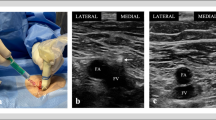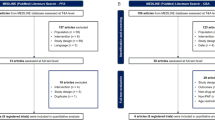Abstract
Background
Integration of intracardiac echocardiography (ICE) and 3D electroanatomic mapping (EAM) system allows transseptal punctures (TSP) without the use of fluoroscopy. Compared with fluoroscopy, ICE provides better visualization of the anatomy relevant to TSP and early recognition of complications. The aim was to evaluate efficacy and safety of entirely ICE-guided TSPs in patients who underwent fluoroless catheter ablation of left-sided tachycardias.
Methods
Consecutive 524 adult and pediatric patients referred to our institution from July 2014 to December 2019 were analyzed. Patients with cardiac implantable electronic devices (CIEDs) were also included. All procedures were performed with ICE-guided TSP combined with 3D EAM. Adverse events following TSP and within 30 days of the procedure were analyzed.
Results
Altogether 949 TSPs (363 double punctures, 76.5%) were performed in 586 fluoroless ablation procedures: 451 (77%) were ablation of atrial fibrillation or atypical flutter, 75 (12.8%) of left-sided accessory pathway, 33 (5.6%) of ventricular tachycardia, and 27 (4.6%) of focal atrial tachycardia. Forty-six (7.8%) procedures were performed in pediatric population and 36 procedures (6.1%) in patients with CIED. Only 2 TSPs were unsuccessful (2/949, 0.2%). Overall procedural complication rate was 1.9% (11/586 procedures). There was only 1 TSP-related pericardial tamponade (2/949, 0.2%). In CIED patients, there was 1 lead dislocation following TSP.
Conclusions
Entirely ICE-guided TSPs for different left-sided tachycardias can be safely and effectively performed in adult and pediatric population without the use of fluoroscopy. However, caution is advised in CIED patients due to possible lead dislocation risk.

Similar content being viewed by others
Data availability
All data generated and analyzed during this study are included in this published article or can be provided upon request.
References
De Ponti R, Cappato R, Curnis A, Della Bella P, Padeletti L, Raviele A, et al. Transseptal catheterization in the electrophysiology laboratory: data from a multicenter survey spanning 12 years. J Am Coll Cardiol. 2006;47:1037–42.
Steinbeck G, Sinner MF, Lutz M, Müller-Nurasyid M, Kääb S, Reinecke H. Incidence of complications related to catheter ablation of atrial fibrillation and atrial flutter: a nationwide in-hospital analysis of administrative data for Germany in 2014. Eur Heart J. 2018;39:4020–9.
Matoshvili Z, Bastani H, Bourke T, Braunschweig F, Drca N, Gudmundsson K, et al. Safety of fluoroscopy-guided transseptal approach for ablation of left-sided arrhythmias. Europace. 2017;19:2023–6.
Bayrak F, Chierchia GB, Namdar M, Yazaki Y, Sarkozy A, de Asmundis C, et al. Added value of transoesophageal echocardiography during transseptal puncture performed by inexperienced operators. Europace. 2012;14:661–5.
Enriquez A, Saenz LC, Rosso R, Silvestry FE, Callans D, Marchlinski FE, et al. Use of intracardiac echocardiography in interventional cardiology: working with the anatomy rather than fighting it. Circulation. 2018;137:2278–94.
Goya M, Frame D, Gache L, Ichishima Y, Tayar DO, Goldstein L, et al. The use of intracardiac echocardiography catheters in endocardial ablation of cardiac arrhythmia: meta-analysis of efficiency, effectiveness, and safety outcomes. J Cardiovasc Electrophysiol. 2020;31:664–73.
Reddy VY, Morales G, Ahmed H, Neuzil P, Dukkipati S, Kim S, et al. Catheter ablation of atrial fibrillation without the use of fluoroscopy. Heart Rhythm. 2010;7:1644–53.
Jan M, Žižek D, Rupar K, Mazić U, Kuhelj D, Lakič N, et al. Fluoroless catheter ablation of various right and left sided supra-ventricular tachycardias in children and adolescents. Int J Card Imaging. 2016;32:1609–16.
Baykaner T, Quadros KK, Thosani A, Yasmeh B, Mitra R, Liu E, et al. Safety and efficacy of zero fluoroscopy transseptal puncture with different approaches. Pacing Clin Electrophysiol. 2020;43:12–8.
Winkle RA, Mead RH, Engel G, Patrawala RA. The use of a radiofrequency needle improves the safety and efficacy of transseptal puncture for atrial fibrillation ablation. Heart Rhythm. 2011;8:1411–5.
Sadek MM, Ramirez FD, Nery PB, Golian M, Redpath CJ, Nair GM, et al. Completely nonfluoroscopic catheter ablation of left atrial arrhythmias and ventricular tachycardia. J Cardiovasc Electrophysiol. 2019;30:78–88.
Heidbuchel H, Wittkampf FH, Vano E, Ernst S, Schilling R, Picano E, et al. Practical ways to reduce radiation dose for patients and staff during device implantations and electrophysiological procedures. Europace. 2014;16:946–64.
Perisinakis K, Damilakis J, Theocharopoulos N, Manios E, Vardas P, Gourtsoyiannis N. Accurate assessment of patient effective radiation dose and associated detriment risk from radiofrequency catheter ablation procedures. Circulation. 2001;104:58–62.
Clark BC, Sumihara K, Berul CI, Moak JP. Off the pedal: Fluoroless transseptal puncture in pediatric supraventricular tachycardia ablation. Pacing Clin Electrophysiol. 2017;40:1254–9.
Sharma SP, Nalamasu R, Gopinathannair R, Vasamreddy C, Lakkireddy D. Transseptal puncture: devices, techniques, and considerations for specific interventions. Curr Cardiol Rep. 2019;21:52.
Marcus GM, Ren X, Tseng ZH, Badhwar N, Lee BK, Lee RJ, et al. Repeat transseptal catheterization after ablation for atrial fibrillation. J Cardiovasc Electrophysiol. 2007;18:55–9.
Arbelo E, Brugada J, Hindricks G, Maggioni A, Tavazzi L, Vardas P, et al. ESC-EURObservational research programme: the atrial fibrillation ablation pilot study, conducted by the European Heart Rhythm Association. Europace. 2012;14:1094–103.
Friedman DJ, Pokorney SD, Ghanem A, Marcello S, Kalsekar I, Yadalam S, et al. Predictors of cardiac perforation with catheter ablation of atrial fibrillation. JACC Clin Electrophysiol. 2020. https://doi.org/10.1016/j.jacep.2020.01.011.
Author information
Authors and Affiliations
Contributions
All authors (DŽ, BA, TPK, JŠ, NK, MJ, and MJ) made substantial contribution to the design of the study, acquisition, analysis, and interpretation of data. All authors also actively participated in drafting the manuscript, its final revisions and corrections. All authors read and approved the final version of the manuscript. All authors agree to be personally accountable for their personal contributions to the manuscript.
Corresponding author
Ethics declarations
Conflict of interest
David Žižek received consulting/advisory board support from Medtronic and Boston Scientific. Bor Antolič and Matevž Jan received proctorship fees from Biosense Webster. All other authors have no relationships relevant to the contents of this paper to disclose.
Ethics approval and consent to participate
The study complies with the Declaration of Helsinki. The fluoroless approach to catheter ablation, including transseptal puncture, was approved by The National Medical Ethics Committee (Komisija za medicinsko etiko Republike Slovenije). All patients (or their parents in case of pediatric patients) gave written informed consent before ablation procedures were performed.
Consent for publication
Not applicable.
Additional information
Publisher’s note
Springer Nature remains neutral with regard to jurisdictional claims in published maps and institutional affiliations.
Electronic supplementary material
Rights and permissions
About this article
Cite this article
Žižek, D., Antolič, B., Prolič Kalinšek, T. et al. Intracardiac echocardiography-guided transseptal puncture for fluoroless catheter ablation of left-sided tachycardias. J Interv Card Electrophysiol 61, 595–602 (2021). https://doi.org/10.1007/s10840-020-00858-z
Received:
Accepted:
Published:
Issue Date:
DOI: https://doi.org/10.1007/s10840-020-00858-z




